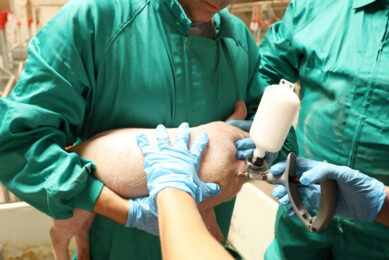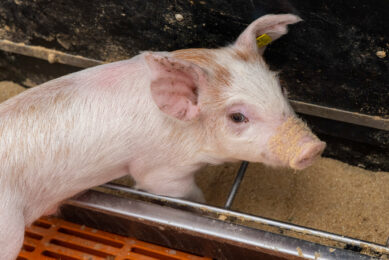How exactly can C. perfringens kill piglets?

Why do new-born piglets sometimes die in pain from an infection with Clostridium perfringens? Swiss researchers think they have found the answer.
The team from the University of Bern investigated the role of C. perfringens and how it can cause fatal intestinal bleeding. The results were published recently in the peer-reviewed journal Cell Host & Microbe. An article on the university’s website states that the discovery may open up the road for vaccinations and medications for use in humans too.
C. perfringens causing fatal illnesses
C. perfringens causes various fatal illnesses in animals and humans. The Institute of Animal Pathology at the University of Bern has been researching intestinal infections in pigs caused by C. perfringens. About 10 years ago, the group was able to demonstrate that the beta toxin produced by the bacteria kills vascular cells and thus causes bleeding in the piglet’s intestine. Until now, however, it was unclear why the toxin attacked these cells and not others.
Julia Bruggisser, biochemist and doctoral student at the institute, has now succeeded in solving the puzzle of this mechanism in an interdisciplinary collaboration between 3 faculties.

Molecule related to intestinal bleeding in piglets
The article on the university’s website described that around 5 years ago, Bruggisser’s colleague and lab technician Marianne Wyder came across a molecule called Platelet-Endothelial Cell Adhesion Molecule-1 (PECAM-1 or CD31). It is located on the surface of various cells and plays a central role in intestinal bleeding in piglets. The actual role of the CD31 molecule is to regulate the interaction between inflammatory cells and the blood vessels. It predominantly occurs on cells which are located on the inside of blood vessels (so-called endothelial cells).
During experiments, it was noted that CD31 and the beta toxin are distributed almost identically on these cells. Prof Horst Posthaus, DVM, and head of the institute, said, “Our project was the result of this initial observation.”

How to do a clinical pig examination?
Bruggisser discovered that the toxin released by the bacteria in the intestine attaches to the CD31. Since the beta toxin numbers among the pore-forming toxins, it thus perforates the cell membrane and kills the endothelial cells. That results in damage to the vessels and bleeding in the intestine.
Better vaccines to prevent disease in pigs
The discovery makes it possible to develop better vaccines in order to prevent the fatal disease in pigs. In the article on the university’s website, Prof Posthaus said, “We also want to investigate whether the attachment of beta toxin to CD31 on the endothelial cells also allows for the development of new forms of therapy, for vascular disease in humans, for example. We have already started more collaborations within the University of Bern to this end.”
The scientific article in Cell Host & Microbe was authored by Julia Bruggisser, Basma Tarek, Marianne Wyder, Philipp Müller, Christoph von Ballmoos, Guillaume Witz, Gaby Enzmann, Urban Deutsch, Britta Engelhardt and Horst Posthaus, University of Bern, Switzerland.











